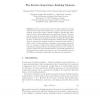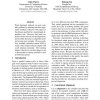695 search results - page 89 / 139 » The structure of intrinsic complexity of learning |
BMCBI
2004
13 years 8 months ago
2004
Background: The increasing number of protein sequences and 3D structure obtained from genomic initiatives is leading many of us to focus on proteomics, and to dedicate our experim...
JMLR
2010
13 years 3 months ago
2010
Inducing a grammar from text has proven to be a notoriously challenging learning task despite decades of research. The primary reason for its difficulty is that in order to induce...
PKDD
2009
Springer
14 years 3 months ago
2009
Springer
Most accurate predictions are typically obtained by learning machines with complex feature spaces (as e.g. induced by kernels). Unfortunately, such decision rules are hardly access...
ICRA
2008
IEEE
14 years 3 months ago
2008
IEEE
— We investigate modeling and recognition of object manipulation actions for the purpose of imitation based learning in robotics. To model the process, we are using a combination...
ACL
2006
13 years 10 months ago
2006
Word alignment methods can gain valuable guidance by ensuring that their alignments maintain cohesion with respect to the phrases specified by a monolingual dependency tree. Howev...


